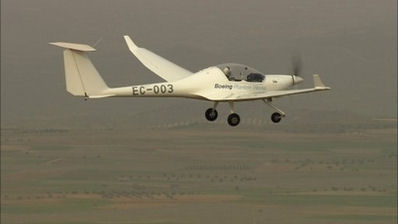Hydrogen has a long (if somewhat spotted) history of making things go up. For starters, hydrogen gas is lighter than air. In fact, it’s even lighter than helium, which is why — along with a US embargo preventing the German government from getting their hands on sufficient quantities of the inert gas that today we use to lift children’s party balloons and to make our voices squeaky — the ill-fated airship Hindenburg was put aloft by hydrogen gas. Sadly, hydrogen’s extra boost of lift power came with a high level of volatility and flammability, and I think we all know the rest of that story…
But there are other ways that hydrogen can make things fly. For example, Boeing has recently announced that, earlier this year, the aircraft manufacturer demonstrated the first-ever manned flight of an airplane powered entirely by a hydrogen battery. NASA tells us that aircraft account for “up to 4 percent of the annual global CO2 emissions from fossil fuels near the Earth’s surface as well as at higher altitudes (25,000 to 50,000 feet),” so there is definitely something to be said for airplanes with a carbon footprint of zero. The question is, how close does this initial 20-minute demo flight get us to a future of zero-emission aviation?
Not very, according to Boeing:
The director of the Ocana research centre, Francisco Escarti, said the hydrogen battery “could be the main source of energy for a small plane” but would likely not become the “primary soruce of energy for big passenger planes”.
“The company will continue to explore their potential as well as that of all durable sources of energy that boost environmental performance,” he said.

But Boeing is not the only game in town where hydrogen-powered flight is concerned. As we reported a couple of months ago, the European Space Agency is looking at an idea called LAPCAT (Long-Term Advanced Propulsion Concepts and Technologie) which promises not only to deliver large-scale, hydrogen-powered commercial aviation, but to return us to the era of supersonic commercial aviation. UK-based Reaction Engines, who have proposed LAPCAT and are currently working with the ESA to study its feasibility, claim that their jet will deliver cruising speeds up to Mach 5, making it possible to fly from Sydney to Brussels in about four hours.
Consider the possibilities: a jet that can fly faster than the Concorde — with a much greater range than Concorde’s, too — which will have none of the Concorde’s negative impact on the atmosphere. Moreover, Reaction Engines claims that the greater range means that LAPCAT will be able to fly routes that can minimize or avoid “supersonic overflight of populated areas.” So we can once again travel faster than sound, this time with less worry about potential resulting noise pollution.

Of course, there’s a hitch to hydrogen-powered aircraft. In fact, it’s the same hitch that you get with hydrogen-powered anything. Hydrogen is a means of transporting energy; it is not itself an energy source — at least not when burned like a conventional fuel. So if we want truly zero-emission aircraft, we need to make sure that whatever is serving up LAPCAT with hydrogen fuel, or charging the batteries of Boeing’s more modest offering, is itself a green and emission-free energy source. Solar, wind, and hydroelectric would all be good ways to produce energy for zero-emission aviation. But if we were to look to look to a future in which all aviation becomes zero-emission, we will need something more scalable and reliable than any of those.
For the near- to mid-term, that probably means nuclear energy. For the longer term, fusion energy will eventually supply us with cheap and abundant power without the risks or drawbacks associated with nuclear fission reactors. (Although it’s important to note that those risks and drawbacks have been considerably reduced in the more recent versions of nuclear fission reactors, which has significantly broadened the appeal of these low-emission power plants.) Mimicking the process by which the sun itself is powered, fusion is perhaps the ultimate natural energy source. And it’s fueled by hydrogen — meaning that a future of zero-emission aviation may be hydrogen-powered in more ways than one.